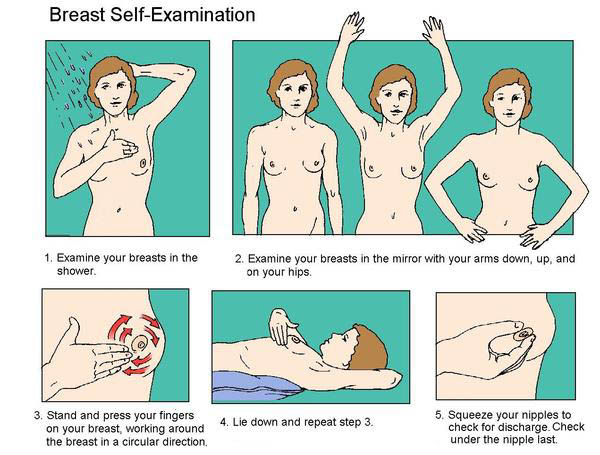The breast is comprised of "lobules (milk-producing glands), ducts (tiny tubes that carry the milk from the lobules to the nipple), and stroma (fatty tissue and connective tissue surrounding the ducts and lobules, blood vessels, and lymphatic vessels)," specifically in females (American Cancer Society, 2015). The American Cancer Society (2015) also notes that the majority of breast cancer cases begin in the ducts. The following website discusses more details related to the breast, and how cancer affects it.
( http://www.cancer.org/cancer/breastcancer/detailedguide/breast-cancer-what-is-breast-cancer ).
The National Breast Cancer Foundation, Incorporated (2012) states that most individuals suffering from breast cancer will likely notice a limited number of symptoms. These can include the following: "changes in the appearance of the breast and/or nipple, leaking discharge from the nipple, and altered sensations of the breast and/or nipples" (National Breast Cancer Foundation, Inc., 2012). It is recommended that everyone regularly self-examine their breasts, making it easier to notice any irregularity.
Picture obtained from "How to do a Breast Self-Examination (2014)" by The Health Guru.
To treat breast cancer, there are several options. Typically, the type will be decided by the severity of the cancer, and how long the body has been affected. However, the most successful treatments are usually completed in combination. Some examples of treatment recommended by the American Cancer Society (2015) include surgery, where the tumor is surgically excised, radiation or chemotherapy, which both aim to kill the cancerous cells, and several others. For more information regarding treatment options, please visit the following website:( http://www.cancer.org/cancer/breastcancer/overviewguide/breast-cancer-overview-treating-general-infor )
Though breast cancer is highly curable, side effects are common during treatment. According to Breast Cancer Care (n.d.), some things experienced are pain, weight loss, menopausal symptoms, and fatigue. However, it should be noted that the side effects are determined by the treatment being administered, and thus, chemotherapy might have different symptoms than surgical excision.
Any cancer is a serious health issue, but with regular doctor visits and self-monitoring, individuals can lessen their risks. With cancer being a genetic mutation, detecting early increases the chances of it being cured.
Works Cited
Breast Cancer Care. (n.d.). Retrieved July 21, 2015, from https://www.breastcancercare.org.uk
How to do a Breast Self-Examination. (2014, May 28). Retrieved July 21, 2015, from http://www.healthguru.sg/health-disease/how-to-do-a-breast-self-examination/
Symptoms and Signs :: The National Breast Cancer Foundation. (2012). Retrieved July 21, 2015, from http://www.nationalbreastcancer.org/breast-cancer-symptoms-and-signs
What is breast cancer? (2015, June 10). Retrieved July 17, 2015, from http://www.cancer.org/cancer/breastcancer/detailedguide/breast-cancer-what-is-breast-cancer

No comments:
Post a Comment